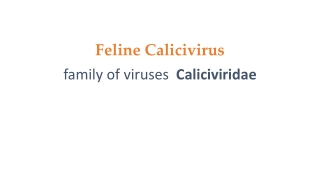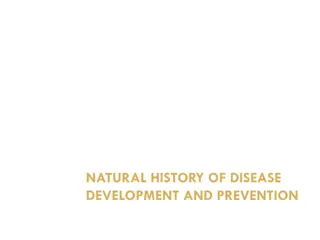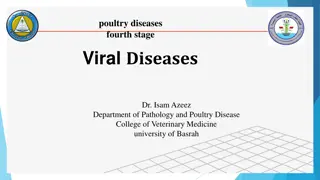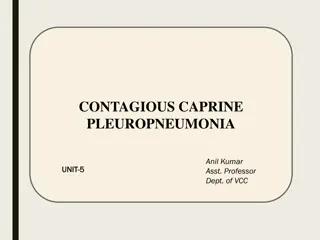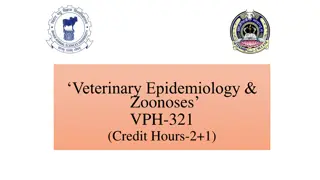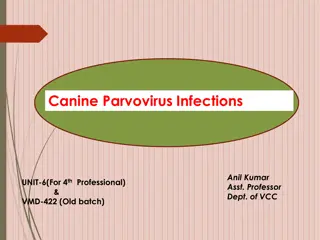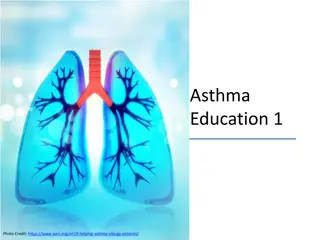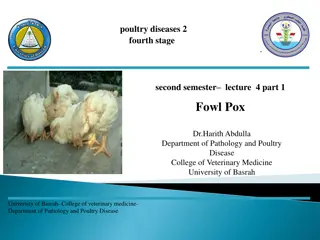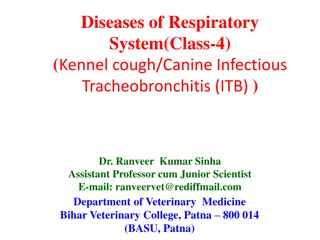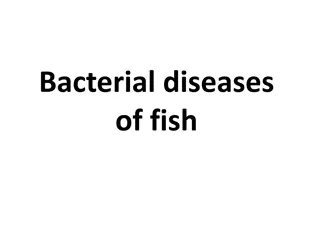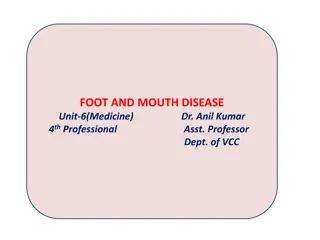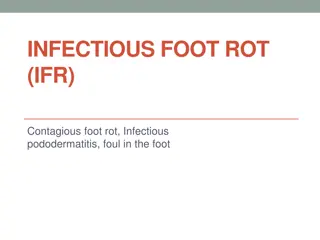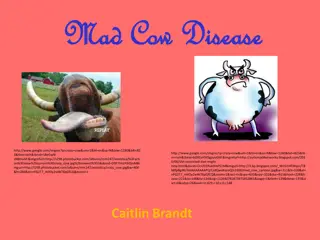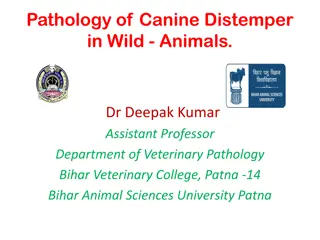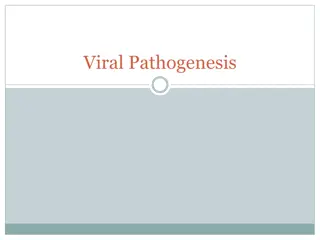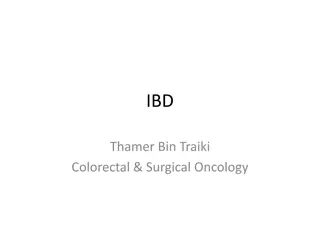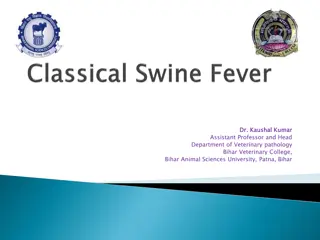Feline Calicivirus
Feline Calicivirus (FCV) is a highly contagious virus that causes respiratory infection and oral disease in cats. It spreads easily in multi-cat environments like shelters and breeding colonies. Learn more about its causes, transmission, and prevention.
0 views • 25 slides
Protect Against Pertussis
Pertussis (whooping cough) and its symptoms, as well as the importance of vaccination. Protect yourself and your loved ones from this contagious disease.
0 views • 10 slides
The Natural History of Disease Development and Prevention
The natural history of disease development outlines the progression of a disease in an individual without intervention, from exposure to outcome. Learning objectives include defining prevention terms, understanding disease severity, prevention levels, and intervention measures. Studying disease prog
4 views • 16 slides
Viral Diseases in Poultry: Newcastle Disease and Avian Influenza
Viral diseases like Newcastle Disease (ND) and Avian Influenza (AI) pose significant threats to poultry farming, impacting bird health and production. ND, caused by Avian paramyxovirus type 1, is highly contagious and manifests in various forms affecting birds' respiratory and nervous systems. On th
7 views • 24 slides
Principles of Epidemiology: Understanding Disease Occurrence and Surveillance
Epidemiology is the study of disease patterns, factors influencing disease occurrence, and the core functions of surveillance, field investigation, and analytic studies. It involves understanding disease characteristics, natural history, and evaluating the effectiveness of activities to mitigate dis
1 views • 25 slides
Contagious Caprine Pleuropneumonia in Goats
Contagious Caprine Pleuropneumonia is a severe and frequently fatal respiratory disease affecting goats in India. Caused by Mycoplasma capricolum subsp. Capripneumoniae, it is not transmissible to cattle or sheep. The disease spreads through close contact and inhalation of respiratory droplets, with
0 views • 6 slides
Insights into Tyzzer's Disease: An Overview of a Bacterial Infection in Laboratory Animals
Tyzzer's disease is an acute bacterial infection affecting rodents and rabbits, caused by Clostridium piliforme. Discovered in 1917 by Ernest Tyzzer, the disease is characterized by necrotic lesions in the caecal mucosa, liver, and heart. Initially known as Bacillus piliformis, it was later renamed
2 views • 21 slides
Foot and Mouth Disease: Overview, Symptoms, and Sequelae
Foot and Mouth Disease, also known as Aphthous fever, is a highly contagious viral infection affecting cloven-hoofed animals. It is characterized by the formation of vesicles and erosions in the mouth, nose, teats, and feet. The disease can cause a fall in milk yield, high fever, loss of appetite, a
1 views • 8 slides
Glanders: A Contagious Bacterial Disease in Animals
Glanders is a contagious bacterial disease primarily affecting equidae but can also infect other animals, including humans. Caused by Burkholderia mallei, it has a historical occurrence and poses risks globally due to its transmission potential. The etiology, survival characteristics, host range, an
0 views • 19 slides
Glanders: Causes, Symptoms, and Transmission
Glanders, also known as Farcy, Equinia, or Malleus, is a contagious disease affecting horses, mules, and donkeys. It is caused by the bacteria Pseudomonas mallei and can be transmitted through direct contact or inhalation. The disease manifests with nodules or ulcers in the respiratory tract and on
0 views • 11 slides
Canine Viral Infection: A Comprehensive Overview
Canine Viral Infection, caused by canine parvovirus-2, is a highly contagious disease affecting dogs, especially puppies. The infection spreads through fecal-oral route and can lead to severe clinical signs like vomiting, diarrhea, and dehydration. The virus replicates in lymphoid tissues, affecting
0 views • 11 slides
Equine Coital Exanthema: Overview, Symptoms, and Management
Equine coital exanthema, caused by Equine Herpesvirus 3, is a contagious venereal disease affecting horses globally. It primarily manifests as genital lesions in stallions and mares, transmitted sexually or through contact with contaminated materials. While it is typically self-limiting, it can be p
1 views • 23 slides
Disease Control and Prevention in Epidemiology
This article discusses disease control processes in epidemiology, including reducing disease incidence, duration, and transmission. It covers public policy interventions, elimination, eradication, and extinction of infectious agents. It also highlights preventable causes of disease and different lev
2 views • 10 slides
Paratuberculosis (Johne's Disease) in Animals
Contagious and fatal, Paratuberculosis, or Johne's Disease, affects the small intestine of ruminants due to Mycobacterium avium subspecies paratuberculosis. It spreads through fecal-oral route, affecting animals' immunity, causing weight loss, decreased milk production, and diarrhea. The infection l
0 views • 14 slides
Asthma: Symptoms, Causes, and Management
Asthma is a lung disease characterized by inflammation and bronchoconstriction, leading to symptoms like wheezing, coughing, shortness of breath, and chest tightness. It is not contagious and can develop at any age, with early signs like eczema potentially leading to asthma later. Recognizing sympto
1 views • 8 slides
Fowl Pox in Avian Species: Causes, Symptoms, and Diagnosis
Fowl Pox, caused by Avipoxvirus, is a contagious disease in birds characterized by wart-like nodules and diphtheritic membranes in the throat and mouth. It has multiple forms, including dry pox, wet pox, and coryza-like form, with varying clinical signs. The disease spreads through mosquitoes, bitin
1 views • 10 slides
Kennel Cough: Contagious Canine Respiratory Disease Overview
Kennel Cough, known as Canine Infectious Tracheobronchitis, is a highly contagious respiratory disease affecting dogs, characterized by acute tracheobronchitis and a paroxysmal cough lasting several days. It is caused by various infectious agents, including Canine Parainfluenza Virus and Bordetella
0 views • 12 slides
Overview of Mycoplasma Species and Contagious Bovine Pleuropneumonia
The Mycoplasma genus, including Acholeplasma and Ureaplasma, consists of Gram-negative bacteria with unique characteristics such as lacking cell walls. Mycoplasma species are responsible for causing various diseases in livestock, including bovine and caprine pleuropneumonia. Contagious Bovine Pleuro
1 views • 13 slides
Common Infective Diseases in Cattle and Their Implications
Infective diseases such as blackquarter, brucellosis, and foot and mouth disease pose significant threats to cattle health and food safety. Blackquarter is a fatal disease caused by Clostridium chauvaei, while brucellosis leads to contagious abortion in cattle. Foot and mouth disease is highly conta
0 views • 17 slides
Pediatric Respiratory Conditions Management Overview
Tuberculosis is a contagious respiratory disease affecting children, with drug therapy involving a 6-month course and nursing management focusing on supportive care and treatment adherence. Prevention strategies include isolation, nutrition, and vaccination. Epistaxis, or nosebleeds, are common in c
0 views • 26 slides
Screening for Peripheral Vascular Disease in Patients with Coronary Artery Disease
Patients with coronary artery disease should be screened for peripheral vascular disease as it is a frequent integrator of global cardiovascular risk. The association of atherosclerosis in various arterial diseases highlights the importance of identifying multisite artery disease. The prevalence and
0 views • 23 slides
Human Disease Symptom Network: Understanding Disease Relationships Through Symptoms and Genes
The Human Disease Symptom Network (HSDN) is constructed using a large-scale medical bibliographic records database to form a network of human diseases based on symptom similarities. By integrating disease-gene associations and protein-protein interaction data, correlations between symptom similarity
1 views • 37 slides
Bacterial Diseases of Fish: Columnaris Disease Overview
Columnaris disease, also known as Saddleback disease, is a common bacterial infection in fish that is often brought about by poor handling and high stress levels. This disease manifests as tail and fin rot, leading to rapid fish mortality. The causative organism, Cytophaga (formerly Flexibacter), is
0 views • 21 slides
Foot and Mouth Disease in Animals: Causes, Symptoms, and Management
Foot and Mouth Disease is an acute, highly contagious illness affecting cloven-hoofed animals, causing vesicles and erosions in the mouth, nose, teats, and feet. The disease is caused by a positive sense, ss-RNA virus with various serotypes. Transmission occurs through inhalation, direct or indirect
0 views • 8 slides
Foot-and-Mouth Disease (FMD) and Bovine Viral Diarrhea (BVD)
Foot-and-mouth disease (FMD) is a highly contagious animal disease affecting cloven-hoofed animals, while Bovine Viral Diarrhea (BVD) is a serious cattle disease caused by the BVD virus. FMD is not transmissible to humans and is caused by different strains of Aphthovirus. Symptoms of FMD include ves
0 views • 12 slides
Comprehensive Overview of Infectious Foot Rot (IFR) in Ruminants
Infectious Foot Rot (IFR) is a contagious disease affecting ruminants worldwide, characterized by severe interdigital dermatitis and lameness. It is caused by Fusobacterium necrophorum and other bacteria, leading to inflammation of the sensitive foot tissues. Various predisposing factors and modes o
0 views • 13 slides
Decoding Genetics: Insights from Alzheimer's Disease Symposium to Type 2 Diabetes Study
Explore the latest findings from the Alzheimer's Disease Genetics Symposium 2019 on disease mechanisms, drug targets, and genetic pathways. Dive into the progress made by the Alzheimer's Disease Genetics Consortium over the past decade. Transition to a Genome-Wide Association Study uncovering suscep
0 views • 42 slides
Analysis of Contagious Sets in Random Graphs
The research delves into the concept of contagious sets in random graphs, focusing on bootstrap percolation, random activation, historical perspectives, recent developments, and NP-hard problems. It explores factors like the size of contagious sets, speed of activation, and open problems in the fiel
0 views • 31 slides
Liver Disease Burden in Tower Hamlets
Dr. Somen Banerjee, Director of Public Health in London Borough Tower Hamlets, highlights the concerning liver disease mortality rates in the area, with high incidence of cirrhosis, cancer, and hepatitis B and C. The data reveals a significant burden of liver diseases such as Non-Alcoholic Fatty Liv
0 views • 18 slides
Inflammatory Bowel Disease: Crohn's Disease and Ulcerative Colitis
Inflammatory Bowel Disease (IBD) encompasses Crohn's disease (CD) and ulcerative colitis (UC), chronic conditions with immunologic basis. This article delves into the epidemiology, pathophysiology, and differences between CD and UC, highlighting clinical features, pathology, and complications like a
0 views • 42 slides
Mad Cow Disease: Causes, Symptoms, and Prevention
Mad Cow Disease, or BSE, is an incurable and fatal brain disease caused by prions affecting cattle. It can be transmitted to humans through contaminated meat, leading to vCJD. While rare and non-contagious, it poses a serious health risk with no known treatment. The disease progresses slowly, affect
0 views • 6 slides
Ultrastructural Alterations of Renal Tissue in a Male Patient with Fabry's Disease
Fabry's disease is a rare X-linked lipid storage disorder characterized by deficient lysosomal alpha-galactosidase A activity. This condition primarily affects males, leading to chronic kidney disease and progression to end-stage renal disease. Kidney involvement is a critical aspect, and high doses
0 views • 24 slides
Canine Distemper in Wild Animals - Pathology and Disease Overview
Canine distemper virus (CDV) poses a significant threat to various carnivore species, including domestic dogs, foxes, wolves, raccoons, bears, and others. This highly contagious disease has been linked to fatalities in lions and emphasizes the importance of understanding its pathology and impact on
0 views • 10 slides
Viral Pathogenesis: Causes and Consequences
Viral pathogenesis involves the process by which a virus leads to disease, exploring the interplay between viral and host factors. It encompasses the concepts of virulence, viral disease, and the effects on infected cells and the host's immune response. Changes within infected cells, including cell
0 views • 26 slides
Exploring the History and Evolution of Coeliac Disease
Samuel Gee's pivotal clinical description of coeliac disease in 1887 unraveled a chain of discoveries leading to the understanding of its genetic and immunological roots. Early connections between wheat and the disease shed light on the domestication of wheat and its impact on human health. Recent i
0 views • 23 slides
Children diseases
Chickenpox, whooping cough, fifth disease, hand, foot and mouth disease, and scarlet fever are common childhood illnesses. These diseases have distinct symptoms, causes, and treatment options. It is essential for parents to recognize the signs early and seek appropriate medical care. Understanding t
0 views • 7 slides
Acquired Heart Disease
Acquired heart disease in children, including rheumatic fever and Kawasaki disease, is crucial for pediatric cardiologists to diagnose and treat effectively. Rheumatic fever, often precipitated by Group A Streptococcal pharyngitis, can lead to rheumatic heart disease if not recognized promptly. Reco
0 views • 36 slides
Understanding Inflammatory Bowel Disease (IBD) and Crohn's Disease
Inflammatory bowel disease (IBD) encompasses conditions like ulcerative colitis and Crohn's disease, with distinguishing factors based on clinical and pathologic criteria. Crohn's disease is a chronic inflammatory condition affecting the gastrointestinal tract with both medical and surgical treatmen
0 views • 51 slides
Anthrax: A Deadly Zoonotic Disease
Anthrax is a life-threatening infectious disease caused by Bacillus anthracis, affecting animals and humans. It is not contagious between humans but can be transmitted from infected animals. Learn about its clinical findings, laboratory diagnosis, treatment, and more in this informative presentation
0 views • 12 slides
Understanding Swine Fever: A Viral Disease in Swine Production
Swine fever, also known as Hog Cholera, is a highly contagious viral disease affecting pigs worldwide. It is characterized by symptoms such as gluing of eyes, generalized hemorrhage, and button ulcers in the intestine. The disease is caused by a pestivirus and can lead to high morbidity and mortalit
0 views • 16 slides
